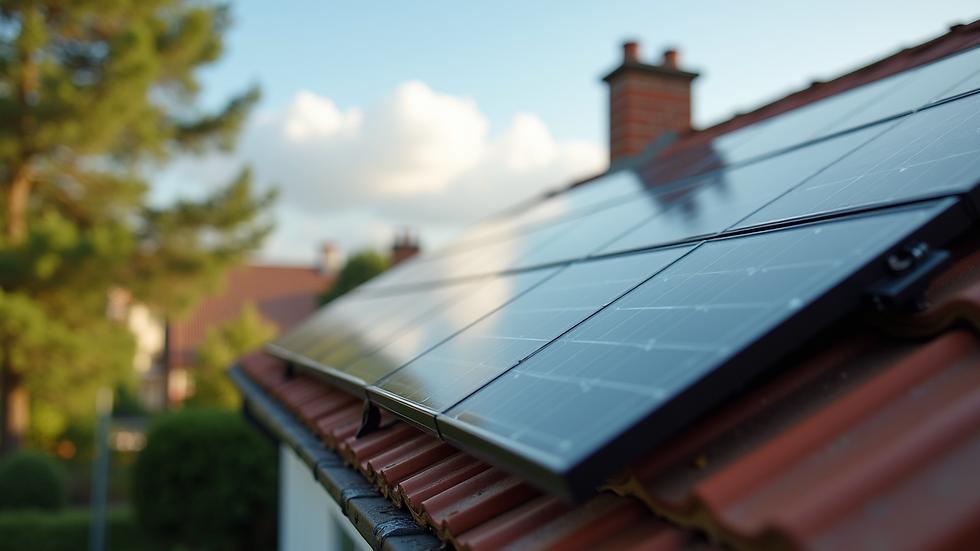How to Access Financial Support for Green Energy
- hollmas
- Jul 10
- 4 min read
As the world shifts toward sustainable practices, many individuals and organizations are seeking ways to incorporate green energy solutions. One of the biggest barriers to adopting renewable energy systems is often the initial investment required. Fortunately, various financial supports, including grants, loans, and incentives, can help you transition to green energy without a hefty price tag. This blog post will guide you on how to access financial support for green energy.
Understanding Renewable Funding
Renewable funding encompasses various financial assistance programs aimed at promoting the adoption of sustainable energy solutions. This could include anything from loans with favorable terms to grants that do not require repayment. Understanding the types of financial support available is the first step towards making your green energy dreams a reality.
Financial incentives vary by location and can be offered by federal, state, and local governments, as well as private organizations. This means it is crucial to research what is available in your area. Generally, the following are the most common types of financial support available:
Grants: Financial assistance that does not need to be repaid. These are often offered by government entities or nonprofits.
Loans: Low-interest loans supporting the purchase and installation of green energy technologies, such as solar panels or wind turbines.
Tax Credits: Reductions in federal and state taxes for energy efficiency improvements or renewable energy installations.
Rebates: Upfront discounts provided by various organizations for specific energy upgrades.
Types of Financial Support for Green Energy
Grants and Incentives
Many governments offer grants and incentives for green energy projects. For instance, the U.S. Department of Energy (DOE) provides a variety of grant programs aimed at supporting renewable energy initiatives. These grants can significantly offset costs related to research, design, or implementation of green technologies.
Moreover, local governments may also offer programs tailored to their communities. Be sure to visit government websites or reach out to local offices to find additional supportive funding initiatives.

Low-Interest Loans
Low-interest loans are another option for financing renewable energy projects. Entities like the Federal Housing Administration (FHA) and the Department of Agriculture provide loans specifically for energy-efficient home improvements. These loans often come with favorable interest rates and terms, making them an attractive option for many.
In addition to federal programs, many states offer their own low-interest loan programs for renewable energy systems. Researching these options can save you a significant amount of money on upfront costs.

Tax Credits
Tax credits are an effective means of incentive that reduces your taxable income based on the amount spent on renewable energy systems. The federal government offers a Renewable Energy Tax Credit, covering a percentage of the cost associated with solar, wind, or geothermal systems.
In addition, some states have their own tax credits that can be combined with federal ones, providing even more savings. Consult a tax advisor to understand how to maximize your benefits from these credits.
What is the REAP Grant in Idaho?
The Rural Energy for America Program (REAP) is a federal grant initiative aimed at supporting renewable energy projects in rural areas. In Idaho, this program provides grants and loan guarantees to agricultural producers and rural small businesses to implement renewable energy systems or improve energy efficiency.
The REAP grants can cover up to 25% of the total project costs, providing an excellent opportunity for those willing to invest in green energy.
Eligibility criteria include:
Being a rural small business or agricultural producer
Demonstration of project feasibility and capability
Providing required documentation
By utilizing REAP grants, you not only contribute to environmental sustainability but also enhance your business's energy efficiency.

Finding Financial Support Resources
Online Tools and Databases
Several comprehensive online databases can help you find available financial support for renewable energy projects:
DSIRE (Database of State Incentives for Renewables & Efficiency): This is one of the most extensive sources for state-specific incentives and policies related to renewable energy.
EnergySage: This platform not only provides comparisons of solar providers but also lists available financial incentives.
These resources make it easier for individuals and organizations to sift through available options and locate financial assistance tailored to their needs.
Local Organizations and Non-Profits
Local organizations focused on sustainability often have insights into financial support programs available in your community. Reach out to environmental NGOs or sustainability-focused groups to see if they offer any funding programs or resources.
Preparing Your Application
Once you’ve identified the financial support you wish to pursue, it’s time to prepare your application. Here are a few tips to ensure your application stands out:
Understand Eligibility Requirements: Every funding opportunity comes with specific criteria. Make sure you meet all the requirements before starting your application.
Gather Necessary Documentation: Most applications will require supporting documents, such as proof of income, project plans, and expenditure plans. Being organized can save you time in the long run.
Write a Compelling Proposal: If your funding option requires a proposal, take time to articulate why you need the funds and how your project promotes renewable energy. Highlight any community benefits or innovative aspects of your project.
Seek Expert Guidance: Consider consulting with financial advisors or professionals experienced in renewable energy funding. They can provide valuable insights and improve your chances of success.
Maximizing Your Financial Support
To ensure that you make the most of your financial support opportunities, adopt a holistic approach to green energy adoption. Combine grants, loans, and incentives with energy efficiency measures. The more comprehensive your approach, the better you can maximize your funding options.
To illustrate, if you secure a grant for solar panel installation, look for additional funding sources that could also cover the costs of energy-efficient appliances or insulation. This multi-faceted strategy can significantly reduce your overall expenses while enhancing your renewable energy usage.
Final Thoughts
Accessing financial support for green energy adoption is not only feasible but can also be a transformative journey towards sustainability. With a wide variety of grants, loans, and incentives available, you can make your shift to a greener lifestyle more affordable.
Whether you're an individual looking to power your home sustainably or a business aiming to reduce energy costs, understanding the types of financial support available is key. Initiatives like the REAP grant in Idaho and other local incentives present unique opportunities to bridge the funding gap.
Remember, each viable option you pursue, including exploring renewable energy funding avenues and utilizing local resources, can contribute to your overall plan. Take the leap towards sustainability today and enjoy a brighter, greener future ahead.




Comments